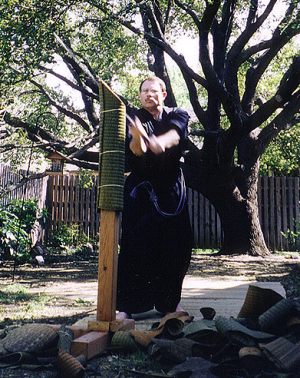
The Japanese Sword Arts have been experiencing an explosion in popularity over the last several years. It wasnít very long ago when the only choice for a relatively inexpensive sword was a refurbished gunto, and the only choices for practicing tameshigiri were beach mats or bamboo. Luckily for those of us crazies that practice this outdated martial art, this has all changed. There are now several makers in China that are exporting inexpensive swords of decent quality. There are also several places to get decent quality materials for tameshigiri. If your dojo is one that practices tameshigiri, or youíve just wanted to give it a try, you may not know what is available today. Even if you do, you may be wondering what the difference is between the various materials available. This article attempts to give a little insight into that question.
Beach mats were once the wara of choice, because there wasnít one! Beach mats are thin reed or grass mats available most places where there is a beach. Good for keeping the sand off, they were as close as most people outside of Japan could get to tatami omote, which had become the (more or less) standard target for tameshigiri in Japan. For those unfamiliar, most houses in Japan still have a tatami room. This is a thick rice straw mat with a woven reed covering (tatami) on the outside (omote) for the floor. This covering is generally replaced yearly. The Toyama Ryu came to embrace tatami omote, rolled and soaked in water, as the standard cutting target at their competitions. This spread to the few other schools in Japan that practice tameshigiri until virtually all of the schools in Japan were cutting the same medium. Used tatami omote, cheap and easily available, made a fairly consistent target of the appropriate size. Outside of Japan though, they were neither cheap nor easily available. Thus the widespread use of beach mats.

The growing popularity of the sword arts, and tameshigiri, outside of Japan has created a demand for better cutting materials. This in turn has resulted in the availability of several alternatives to the venerable beach mat. Since I wondered just what the differences were between the different materials available, I decided that it was time to find out. I ordered mats from various places and ran them through a side-by-side comparison. No, it wasnít a strictly controlled scientific experiment. It was just Doug Stryker, a dojo mate, and myself whacking at the different targets and discussing our impressions. For a little consistency in our testing, we were performing the Toyama Ryu cutting pattern called Rokudan Giri. This pattern consists of six cuts, left to right kesa giri, right to left kesa, another right to left kesa followed by a left to right kiriage, one more right to left kesa followed by a left to right ichimonji or suihei, whatever your school calls a flat horizontal cut.
The mats I purchased for our little test were: used tatami omote, the Toyama Ryu standard, as well as beach mats from Bob Elder at www.ecmas.com. New tatami omote manufactured specifically for tameshigiri from Mugen Dachi Co. at www.tameshigiri.com. New Bugei wara and Bugei goza from Bugei Trading Co. at www.bugei.com. These are all readily available and sold specifically for use in tameshigiri.
Prior to rolling the targets, I decided to check out their composition. The beach mats were loosely woven of some type of flattened grass or thin reed. They felt very dry and very pliable. The Bugei wara were made of a dark reed, woven about medium tightness. The reeds were quite round and fairly large in diameter, but the walls were thin making them fairly pliable also. The Mugen Dachi, the used tatami, and the Bugei goza all seemed to be made of the same type of reed. The used tatami was quite a bit drier, and had some obvious flattening from use. The Mugen Dachi and Bugei mats were both still fairly green. The Mugen Dachi had the thinnest diameter reeds. The used tatami had a reed size in the middle, but they had the tightest weave of the three. The Bugei goza had noticeably larger reeds, and their weave tightness was on par with Mugen Dachiís. They all three felt fairly stiff and sturdy in relation to the other two.
We rolled all of the mats in single and double mat targets, except for the beach mats. These we rolled in two and four mat targets because I knew from experience that they are much less dense than the other materials. Herein follows a brief comparison of the act of rolling the targets up:
The beach mats were a pain! They were fairly difficult to roll tightly. I didnít remember them being such a pain when I used to use them before, but I guess itís just those rose colored glasses we all tend to don when we look back in time.
The used tatami were much easier to roll, but they do tend to shed reeds off the ends quite a bit. I had to make sure and do a thorough clean up afterward to avoid spousal wrath as we were in my kitchen at the time.
We had a few problems with the Bugei wara as they are made from a different type of reed that seemed harder to get rolled tightly. Add that to the fact that they are quite tall, and it gave us a little difficulty.
The Bugei goza on the other hand were very easy to roll. You could tell just from rolling them that they were quite a bit thicker than the others.
The Mugen Dachi tatami were the easiest to roll. They also smelled like fresh hay, as opposed to the used tatamiís smell of old feet, although they did tend to leave your hands with a green tinge.
All the targets, with the exception of the single Mugen Dachi and double beach mats, were soaked for 30 hours. The single Mugen Dachi and the double beach mats were soaked 12 hours. The Bugei wara are quite a bit taller than the other mats. As a consequence, they wouldnít fit in my normal soaking tubs. (I use a large size plastic tub, lay the mats inside, and put a smaller tub on top to hold the mats submerged.) My wonderful spouse suggested using the bathtub upstairs. They just fit in the tub, so I was ready to go. I have to mention that this earned me a bit of that spousal wrath I tried to avoid earlier. I found out afterward that they leave a serious bathtub ring that took quite a bit of scrubbing to remove! I am no longer allowed to employ the tub for soaking mats.
Now a few numbers for us engineering geeks! I measured the circumference of each of the soaked targets purely out of curiosity. Here are the results.
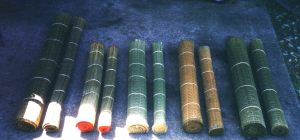
Double beach mat10.0Ē
Single Mugen Dachi10.25Ē
Single tatami omote10.5Ē
Single Bugei wara10.0Ē
Single Bugei goza13.0Ē
Four beach mat 14.0Ē
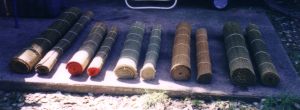
Double Mugen Dachi14.25Ē
Double tatami omote15.0Ē
Double Bugei wara15.5Ē
Double Bugei goza17.5Ē

Let the hacking begin! We started out with the single Bugei wara. I have to mention that the single Bugei wara had a serious tendency to bend when we spiked it. It wasnít a problem to straighten it out once we got it on there though. Boy that thing looked tall on the stand. My cutting stand is a bit tall to begin with, so Doug seriously had to reach for that first cut!
The Bugei wara cut very easily. If your technique was good, you could zip right through it. It did give enough resistance to tell when you were right on or just a bit off. As a test, I purposely hacked with bad hasuji. (I swear it was on purpose!) The sword tracked through the target and left a nice scoop shape without any harm coming to the sword.
Next up was the double beach mat. It cut as easily as the Bugei wara, but felt squishy. That was the only way to describe it. The beach mat wasnít very firm so, when purposely hit poorly, it just bent over in the middle. I also have to mention that it tended to leave a sticky residue on the blade. Iím not sure why, I just wiped it off and went on.
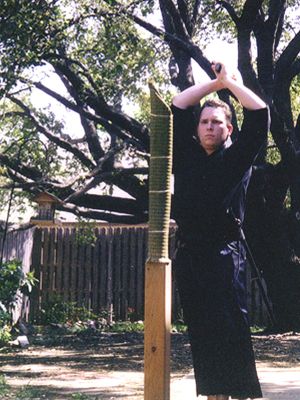
The single Mugen Dachi mat was next. This one felt a bit more solid when spiking it. It also felt much more solid than the previous two when cutting, requiring a bit more tip speed to cut decently. It produced that satisfying zip sound when the cut was good. When I purposely hit this target poorly, the cut stopped and torqued my blade. Not enough to bend it, but I was being careful. I decided that was enough of that little experiment and dropped that particular test. Iíve had to straighten my sword before, and I didnít want to have to do it on purpose!
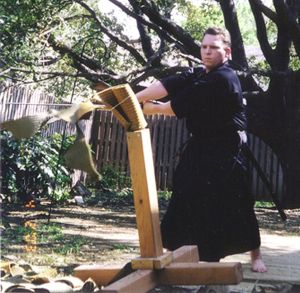
The single used tatami was heavier than the previous targets. It required more speed than the Mugen Dachi mat. This is the first one that Doug had a problem completing a cut. He missed the ichimonji giri. On his redo (the good part about practice is that you get to redo when you mess up!), he cut cleanly.
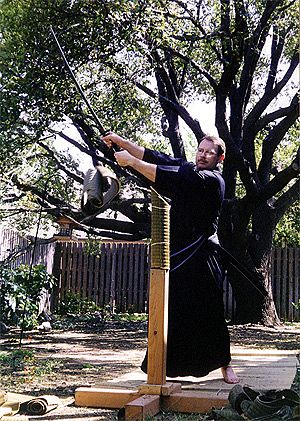
The final target in the single rolls was the Bugei goza. This was the heaviest, and hardest to spike. My first kesa giri stuck for lack of tip speed. I had to put a bit more power into it to complete all the cuts. Doug had a hard time with it. He struggled to get enough tip speed for the kiriage and the ichimonji. Those are pretty tough mats!
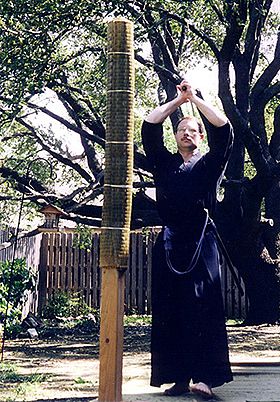
On to the doubles! We followed the same order as before, starting with the Bugei wara. It still amazed me how tall that wara looked after cutting the others.
It wasnít much harder to cut the double mat of wara than the single. It didnít really require any more tip speed, but it did require you to be a bit more careful of your hasuji. We both agreed that they were a lot of fun to cut.
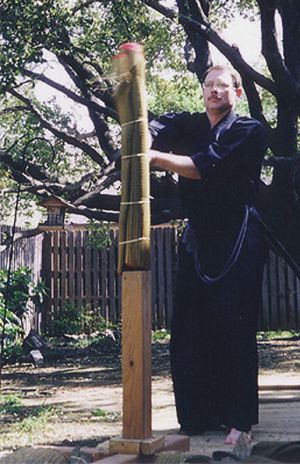
The four roll of beach mat was actually a bit easier to cut than the two roll as strange as it sounds. The extra size of the roll kept it from bending when you were a bit off, so it zipped right through. I decided to be brave and purposely hit it badly. I swear it was on purpose! It cut through in a nice scoop shape without feeling like it caught at all.
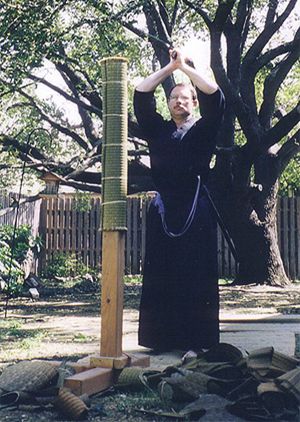
The Mugen Dachi mats were next, making a satisfying thump when you spiked the double roll. These required some decent tip speed as well as good hasuji to get through. These grabbed your sword if you were off a bit. Definitely a sword bender if your concentration wavered. Doug and I both had to take a couple of tries at it to get the ichimonji giri clean.

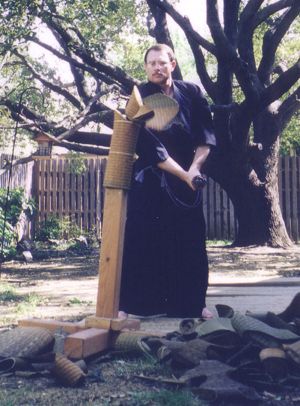
Our next challenge, the double roll of used tatami, required a lot of focus and speed to cut well. I love that zip sound that tatami makes when your cut is good! Doug experienced real difficulties making kiriage and ichimonji with the double mats. It was ďknock over the standĒ time. Everyone that has cut tatami with a horizontal cut has had that happen to them at least once. You try to put enough speed in to cut cleanly, but the angle is a little off and over she goes!
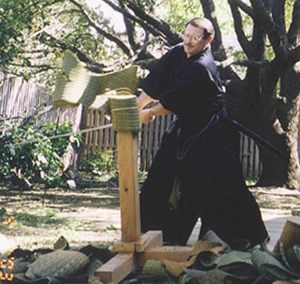
Up to this point I was feeling pretty good because I was doing fairly well with my cuts. I had a bit of that smugness that you try to avoid, but just canít help feeling, when your cuts are on and your training partner is having an off day. Well, all that crashed to a halt when we began cutting the noticeably heavier double rolls of Bugei goza. I had a bit of trouble spiking the single roll, but the weight of the double roll just smacked it down on the spike. Doug just couldnít get either the kiriage or the ichimonji on this one despite a couple of re-tries. I didnít fare much better, and firmly stuck my first attempt at kiriage lifting the target completely off of the stand. It took a couple of re-tries in order to get through the kiriage and ichimonji. The double Bugei goza required a whole lot of speed as well as good blade alignment, quite a challenge! In this picture, you can see where I stuck the preceding cut!
After discussing our impressions, the results were in! These are the conclusions that we came to Ö
The beach mats were OK if you canít get hold of anything else. The advantage is that they are easily available. We are definitely spoiled for better target material though!
The Bugei wara were lots of fun, but not much challenge. We concluded that these would be good for the beginning students as they cut easily and so wonít bend your sword on a bad cut. They are stiff enough to show where the hasuji was off, or the angle of attack was bad. They are quite a bit taller than the others. This would potentially allow for a greater number of cuts per target, but you have to stretch for those first ones.
The new tatami from Mugen Dachi make a good target. They are very consistent in size and density, and smell like fresh tea when you soak them. They are easier to cut than the used tatami, but give enough resistance that you have to be correct in your technique and have good speed in order to cut cleanly.
The used tatami from Bob Elder, the Japanese standard, is used at the various Tai Kai held in the U.S. They are tougher to cut than the Mugen Dachi mats, and require good speed and technique or you stand a good chance of bending your sword. These can be a challenge to consistently cut well. The down side is the fact that they definitely can vary from target to target, and smell like bare feet!
The Bugei goza, the toughest of the targets we tried, are noticeably heavier and larger than the others. Use these if you are feeling cocky and looking for a challenge. I donít think I would have the less experienced guys cut these though, as they would easily bend your sword if you hit them badly. The Bugei goza were the most expensive of the lot, but they were a lot of fun for the challenge factor.
There it is. I warned you at the beginning that it was unscientific. Despite that fact, I hope that you have come away with a better understanding of the target materials available for tameshigiri today. If you are looking for more insight, do like I did and buy some from each of the companies listed. Itís interesting, and gives you a good excuse to do a lot of cutting! Just remember, donít soak the Bugei wara in the bathtub!
Happy cutting!